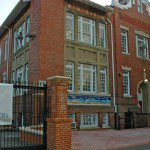Hyde-Addison
By • November 6, 2012 0 1646

You might not see them right away, but you sure can hear them. The teacher bellows, “Supermans!” and a bunch of people a quarter of his size giggle and reach out their arms. “Now, Hulk,” he rumbles, flexing his biceps, as several smaller pairs of arms Hulk out on the blacktop. “Batmaaaaans!” he sings, his rapt audience following every move.
A half block from busy Wisconsin Avenue, where the buses blow exhaust and the cab drivers honk, Hyde-Addison Elementary School is a vibrant, integral part of Georgetown life. This D.C. public school is a place of non-stop action—with 15 classrooms, a library, a cafeteria and a science lab—even after school. “For starters,” says Kara Sullivan, whose son Curtis is in Kindergarten at Hyde, “the strong sense of community is strengthened by seeing classmates, teachers, parents, and Hyde t-shirts as we walk around Georgetown. Where my elementary school had school buses lines up to swiftly take kids away from school at 3:15, there’s a lingering open play date for all kids after Hyde gets out.”
The social curriculum, in the playground, is just as important as what goes inside the school’s walls. Hyde operates on a philosophy that positive interaction is crucial to learning and that learning itself is not simply academic learning. One of the school’s tenets reads, “There is a set of social skills that kids need to be successful: cooperation, assertion, responsibility empathy and self-control.” The school’s physical layout and its meetings and rules are designed to encourage positive interaction—between students and teachers, parents and administrators. And, though it is not explicitly stated, between the school and its environment.
Hyde might once have been a place that drove parents to move out of Georgetown and ignored by those who could afford to send their children elsewhere. Now, Hyde pulls families into Georgetown. The price is right, the commute to school a pleasant stroll, the parents and kids proud of the place. “Georgetown often feels like a small town tucked in a big city,” says Dana Nerenberg, Hyde’s principal. She adds that the school benefits greatly from the community, from volunteers to partnerships.
A local school makes the big city seem manageable and, perhaps, not so scary. “One of the benefits of a neighborhood school is having other kids to play with after school and on weekends,” says Leslie Maysak, who has two boys at Hyde and a block-long commute. “As well as, for me as a parent, knowing the other families personally and having a network of people that can count on each other to pick up your child in a pinch or keep an eye on them for a few minutes,”
Hyde’s presence makes Georgetown about more than just shopping and (lack of) parking. Bob Tompkins’s son, Jack, is in first grade. “To really be a community,” he says, “you have to cover all the aspects of life. It is great that among all the other things Georgetown has to offer, it is a great place to raise a family.”
Ten years ago, there was zero buzz about Hyde. For some parents, sending a kid there was a radical move; few of their neighbors in Georgetown did. Many of the kids who grew up near Hyde were driven, or took the bus, up and out Wisconsin Avenue to private school. Now, Hyde is a strong and growing part of the life of the neighborhood. Enrollments are up, and interest in the school is high. With the PTA’s help, the school has bought iPads and intends to incorporate them into next year’s curriculum. The school is looking to expand its library and build a gym.
- Dean Alexander
- Photo courtesy of Hyde-Addison School




